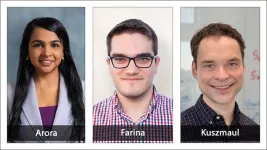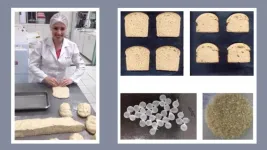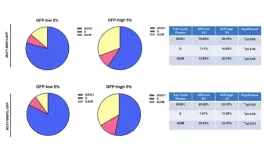(Press-News.org) ACM, the Association for Computing Machinery, today announced that Nivedita Arora, of Northwestern University is the recipient of the ACM Doctoral Dissertation Award for her dissertation “Sustainable Interactive Wireless Stickers: From Materials to Devices to Applications,” which demonstrated wireless and batteryless sensor nodes using novel materials and radio backscatter.
Arora’s research envisions creating sustainable computational materials that operate by harvesting energy from the environment and, at the end of their life cycle, can be responsibly composted or recycled. Her research process involves working at the intersection of materials, methods of fabrication, low-power systems, and HCI. She actively looks to apply her work to application domains such as smart homes, health, climate change, and wildlife monitoring.
Arora’s dissertation makes truly groundbreaking contributions to the fields of Ubiquitous Computing and Human-Computer Interaction. Today’s Internet of Things (IoT) devices are bulky, require battery maintenance, and involve costly installation. In contrast, Arora shows how the computational capabilities of sensing, communication, and display can be diffused into materials and everyday objects. She builds interactive stickers that are inexpensive, and easy to deploy and sustainably operate by harvesting energy from body heat or indoor light. She demonstrates this idea over a series of projects. Her first effort, SATURN, is a thin, flexible multi-layer material that is a self-sustaining audio sensor. Specifically, it uses the vibration itself to power the ability to capture and encode the vibration sensor. SATURN was extended to ZEUSSS to use passive RF backscatter for wireless transmission on the vibration signal. She followed this up with the MARS platform that produces an extremely low-power (less than a microwatt) resonance circuit that varies its frequency based on user interaction with interfaces that create inductive or capacitive loads on the circuit. Coupling this circuit with FM passive backscatter and ambient power harvesting allows user interfaces such as touch-sensitive buttons, sliders, and vibration sensors to communicate at a distance. The result of these three projects is a flat user interface in a post-it note form factor that can be deployed in the environment simply by sticking it to a flat surface. The flat user interface and mobile design allows for applications such as light switches or audio volume sliders that can simply be pasted where they are needed without worrying about wiring the infrastructure or maintaining batteries.
The final project, VENUS, adds output in the form of low-power display technologies to provide immediate feedback on the surface of the computational material, opening a wide variety of user-facing interaction scenarios. Her work also showed that it is possible to power these circuits through the transfer of body heat when a user touches the button, which can also be used to protect privacy.
Arora is an Assistant Professor in the Electrical and Computer Engineering and (by courtesy) Computer Science Department, as well as the Allen K. and Johnnie Cordell Breed Jr. Professor of Design at Northwestern University. Her research involves rethinking the computing stack from a sustainability-first approach for its entire life-cycle: manufacturing, operation, and disposal. Arora received a PhD in Computer Science and an MS In Human-Computer Interaction from the Georgia Institute of Technology.
Honorable Mentions
Honorable Mentions for the ACM Doctoral Dissertation Award go to Gabriele Farina of the Massachusetts Institute of Technology, and William Kuszmaul of Harvard University.
Farina’s dissertation, “Game-Theoretic Decision Making in Imperfect-Information Games” was recognized for laying modern learning foundations for decision-making in imperfect-information sequential games, resolving long-standing questions, and demonstrating state-of-the-art theoretical and practical performance.
Farina is an Assistant Professor in the Electrical Engineering and Computer Science Department (EECS) at the Massachusetts Institute of Technology. His research interests include artificial intelligence, machine learning, optimization, and game theory. He received a PhD in Computer Science from Carnegie Mellon University.
Kuszmaul’s dissertation, “Randomized Data Structures: New Perspectives and Hidden Surprises,” is recognized for contributions to the field of randomized data structures that overturn conventional wisdom and widely believed conjecture.
Kuszmaul’s research focuses on algorithms, data structures, and probability. He received a PhD in Computer Science from the Massachusetts Institute of Technology and is presently doing Post Doctoral work at Harvard University. In August, he will be starting as an assistant professor in the Computer Science Department at Carnegie Mellon University.
About the ACM Doctoral Dissertation Award
Presented annually to the author(s) of the best doctoral dissertation(s) in computer science and engineering. The Doctoral Dissertation Award is accompanied by a prize of $20,000, and the Honorable Mention Award is accompanied by a prize totaling $10,000. Winning dissertations will be published in the ACM Digital Library as part of the ACM Books Series.
About ACM
ACM, the Association for Computing Machinery is the world’s largest educational and scientific computing society, uniting computing educators, researchers and professionals to inspire dialogue, share resources and address the field’s challenges. ACM strengthens the computing profession’s collective voice through strong leadership, promotion of the highest standards, and recognition of technical excellence. ACM supports the professional growth of its members by providing opportunities for life-long learning, career development, and professional networking.
###
END
Forecasters can use images in social media to better communicate weather related hazards of hurricanes, according to a pair of new studies.
Scientists at the U.S. National Science Foundation National Center for Atmospheric Research (NSF NCAR) analyzed 2017 Twitter (now X) data related to two hurricanes – Harvey and Irma. The researchers found that forecast information communicated in the early stages of storm development, when the threat posed by a hurricane is uncertain, sets the stage for how people react to subsequent ...
The ketogenic diet has its fanatics and detractors among dieters, but either way, the diet has a scientifically documented impact on memory in mice. Whlie uncovering how the high fat, low carbohydrate diet boosts memory in older mice, Buck scientists and a team from the University of Chile identified a new molecular signaling pathway that improves synapse function and helps explain the diet’s benefit on brain health and aging. Published in the June 5, 2024 issue of Cell Reports Medicine, the findings provide new directions for targeting the memory effects on a molecular level, without requiring a ketogenic diet or even the byproducts of it.
“Our ...
Brazilian researchers have developed functional bread with the potential to prevent asthma, a respiratory disorder responsible for some 350,000 hospitalizations per year in the SUS (Sistema Único de Saúde), the nation’s public healthcare network.
The formulation, for which a patent application has been filed in Brazil (BR1020210266465), is described in an article published in the journal Current Developments in Nutrition. It contains Saccharomyces cerevisiae UFMG A-905, ...
Potential New Treatment Option for Diabetic Retinopathy
OU researcher developing potential new treatment for diabetic retinopathy that could address the problem much earlier.
OKLAHOMA CITY, OKLA. – Patients with diabetes face a host of potential health problems as they work to manage the chronic disease. Still, one concern that seems to weigh heavily is the risk of losing their sight through a condition known as diabetic retinopathy.
Researchers at the University of Oklahoma Health Sciences and Memorial Sloan Kettering (MSK) Cancer Center are studying a new, revolutionary treatment for diabetic retinopathy that could change the prognosis ...
Embargoed for release until 5:00 p.m. ET on Monday 17 June 2024
Annals of Internal Medicine Tip Sheet
@Annalsofim
Below please find summaries of new articles that will be published in the next issue of Annals of Internal Medicine. The summaries are not intended to substitute for the full articles as a source of information. This information is under strict embargo and by taking it into possession, media representatives are committing to the terms of the embargo not ...
Poor diet continues to take a toll on American adults. It’s a major risk factor for obesity, type 2 diabetes, cardiovascular disease, and certain cancers, and more than one million Americans die every year from diet-related diseases, according to the Food and Drug Administration. Poor diet and food insecurity is also costly, attributing to an estimated $1.1 trillion in healthcare expenditures and lost productivity. These burdens also contribute to major health disparities by income, education, zip code, race, and ethnicity.
In a study from the Food is Medicine Institute at the Friedman School of Nutrition Science and Policy at Tufts University published today in ...
A new aging atlas gives scientists an in-depth view of how individual cells and tissues in worms age and how different lifespan-extending strategies might stop the clock.
Aging impacts all the tissues in our body – from our muscles to our skin. Figuring out how individual tissues and cells age could help researchers better understand the aging process and aid in the development of anti-aging treatments.
Due to their short lifespans, simple body plans, and genetic similarity to humans, many researchers study aging in roundworms. To look at aging at the level of tissues and cells, a team of researchers from HHMI's Janelia ...
By Beth Miller
Human brain diseases, such as Parkinson’s disease, involve damage in more than one region of the brain, requiring technology that could precisely and flexibly address all affected regions simultaneously. Researchers at Washington University in St. Louis have developed a noninvasive technology combining a holographic acoustic device with genetic engineering that allows them to precisely target affected neurons in the brain, creating the potential to precisely modulate selected cell ...
Each of us individually is the accumulated product of thousands of generations that have come before us in an unbroken line. Our culture and technology today are also the result of thousands of years of accumulated and remixed cultural knowledge.
But when did our earliest ancestors begin to make connections and start to build on the knowledge of others, setting us apart from other primates? Cumulative culture — the accumulation of technological modifications and improvements over generations — allowed humans to adapt to a diversity of environments and challenges. But, it is unclear when cumulative culture first developed during hominin evolution.
A study published ...
“[...] our current work has provided a novel strategy to enrich for a sub-population of cancer cells, with high basal levels of mitophagy.”
BUFFALO, NY- June 17, 2024 – A new research paper was published on the cover of Aging (listed by MEDLINE/PubMed as "Aging (Albany NY)" and "Aging-US" by Web of Science) Volume 16, Issue 11, entitled, “Mitophagy and cancer: role of BNIP3/BNIP3L as energetic drivers of stemness features, ATP production, proliferation, and cell migration.”
Mitophagy is a selective form of autophagy which permits ...




